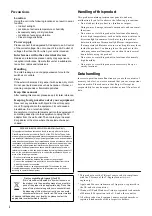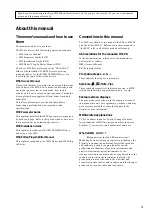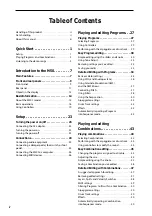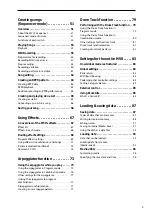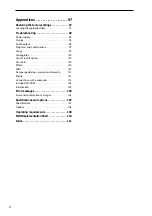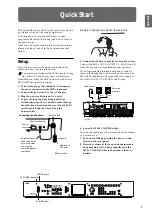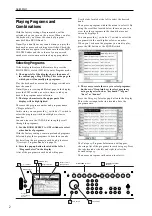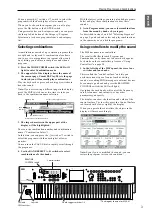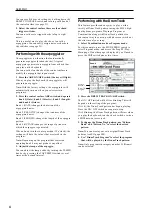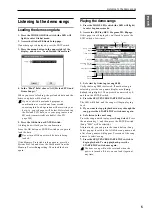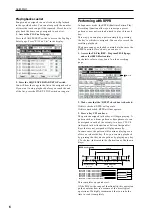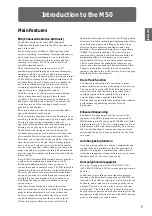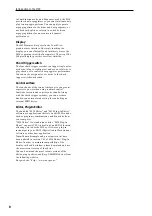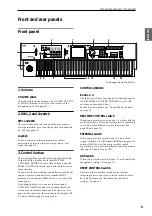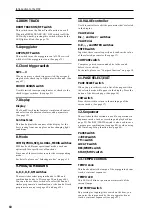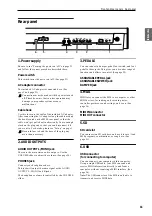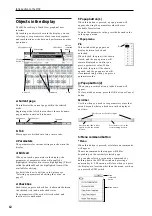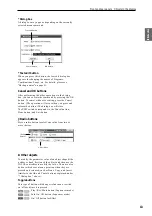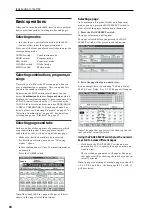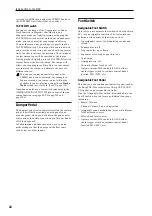
Introduction
Program
Combination
Sequencer
Effect
Arpeggio
Drum Track
Global
Media
7
Introduction to the M50
Main Features
EDS (Enhanced Definition Synthesis)
The M50 is based on the same EDS (Enhanced
Definition Synthesis) found in the M3, delivering rich
and vivid sound.
Each voice has two oscillators (allowing four-stage
velocity switching/crossfading/layering) and can use
up to eight (stereo) multisamples, up to four filters
(two filters per oscillator with four modes and four
routings), two amps, five LFOs, and five EGs, all
available simultaneously.
The oscillator section provides a total of 1,077
multisamples (including seven stereo multisamples)
sampled at 48 kHz, as well as 1,609 drum samples
(including 116 stereo drum samples), giving you a total
of 256 Mbytes of sample data (when considered as 16-
bit linear data). These PCM sources are available for
use in the oscillator section via four-way velocity
switching/crossfading/layering to create a broad
range of expressive, high-quality sounds.
The filter section - so vital to creative sound design -
lets you simultaneously use two filters for each
oscillator. Filter types include low-pass, high-pass,
band-pass, and band-reject (notch). You can use the
two filters in any of four routings: single, serial,
parallel, or 24 dB mode.
The amp section provides a driver circuit that adds
edge and character to the sound.
The key tracking generator allows the filtering to vary
according to the keyboard range; you can apply subtle
filtering for convincing simulation sounds, or
aggressive filtering that produces drastic changes in
filtering as you play up or down the keyboard.
The M50 takes advantage of its lavish amount of
available processing power to produce ultra-fast and
ultra-smooth EGs (envelope generators) and LFOs.
EGs allow you to specify how the sound develops over
time, from its onset to its end. Each EG stage (attack,
decay, slope, and release), gives you detailed control
over how the tone and volume change over time, and
make it possible to program anything from simulated
acoustic sounds to vintage synthesizer sounds with the
utmost detail.
Korg’s AMS (Alternate Modulation Sources) provides
a rich array of modulation possibilities, with 50
different modulation sources that you can use to
control the sound in complex ways. The M50 takes this
classic Korg feature even further, via the AMS Mixers.
These let you create even more detailed modulation
designs by mixing two modulation sources together,
multiplying one modulation source by another, or
modifying the shape of the modulation source in
various ways.
Programs, Drum Tracks, and each of the sixteen
timbres/tracks has its own three-band EQ, letting you
make detailed adjustments to the tonal character.
To let you shape the final character of the overall
sound, the effect section provides up to five insert
effects, two master effects, and one total effect. In
addition to delay and reverb, a total of 170 high-quality
effects are available, including modulation-type effects
such as chorus, phaser, and flanger; dynamic-type
effects such as compressor and limiter; and amp-
modeling effects generated using Korg’s proprietary
“REMS” modeling technology. There are also two
common LFOs that can be shared between different
modulation effects. For example, you can create
sophisticated effects such as using a single common
LFO to synchronize the modulation frequency of a
phaser and a flanger used on different timbres. Effect
dynamic modulation (Dmod) lets you control the
sound or the effects in a wide variety of ways, ranging
from the subtle to the dramatic.
Drum Track function
The Drum Track function lets you listen to drum
patterns while you construct the outline of your song.
You can easily select the M50’s built-in patterns or
create your own, and then start the pattern from a
specified region of the keyboard or by playing a
velocity higher than a specified threshold.
This function is also useful for anything from realtime
performance to generating sketches for song
production
Enhanced Sequencing
The heart of any music production system is the
sequencer. The M50’s sequencer lets you record 16
MIDI tracks, up to 128 songs, and 210,000 notes. With a
high resolution of 1/480, every timing nuance of your
performance will be captured accurately. You can use
the Cue List function to create your song section by
section and then play it back as a medley in the form
you want.
Auto Song Setup function
Auto Song Setup takes care of many assignment and
routing tasks automatically, so that the sequencer is
armed with programs, combinations, effects, drum
track and arpeggiator settings making it easy to create
the basic tracks at the core of your song.
Dual polyphonic arpeggiator
Five preset arpeggio patterns (UP, DOWN, ALT1,
ALT2, RANDOM) and 1,028 user arpeggio patterns are
built-in.
In addition to providing conventional arpeggiator
functions, the polyphonic arpeggiator of the M50 can
respond to the pitches or timing at which you play the
keyboard, and produce a diverse range of chords or
phrases. This can be used to play a variety of drum
phrases (the “Fixed Note Mode” is ideal for drums),
bass phrases, or guitar and keyboard backing riffs. The
arpeggiator is also effective for use with subtly moving
pads, synth sounds, or sound effects.
Содержание EASYSTART M50
Страница 1: ...3 E Owner s Manual ...
Страница 84: ...Arpeggiator function 78 ...
Страница 88: ...Drum Track function 82 ...
Страница 92: ...Settings for the entire M50 86 ...


